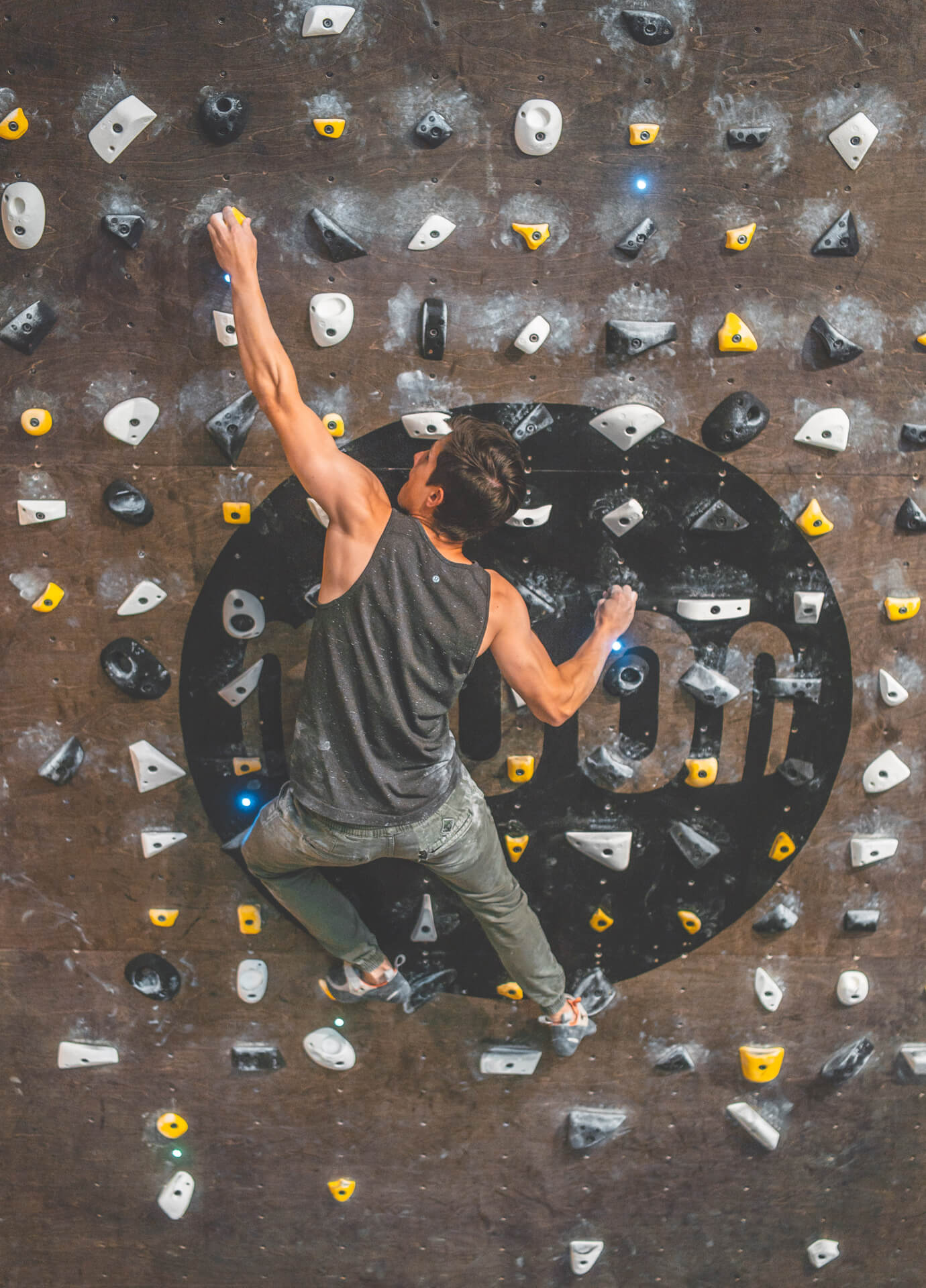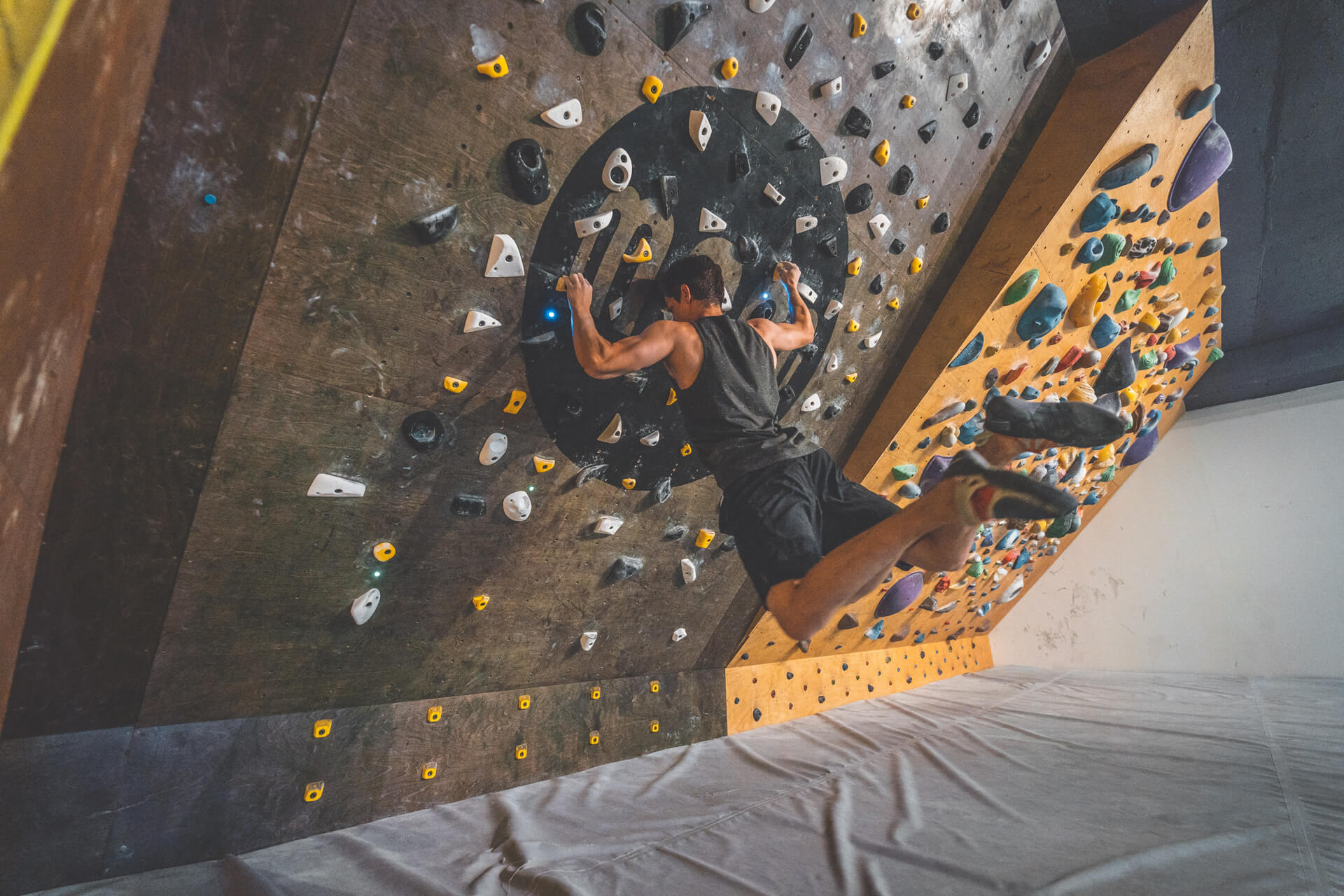A few tips for training on the Moon Board
Let’s talk training and what our Moon Board can do to increase your climbing performance. Have you tried it yet? If you have, you probably noticed the very distinct climbing style it requires. If not, we suggest you download the Moon Climbing app and pay a visit to the silo.
At first try, some of you might feel extremely strong on the Moon Board, whilst others might feel completely shut down. Don’t worry. This is normal because of the very specific style required when climbing on the Moon Board. Let’s first examine what makes it so specific before going through some tips for your training.
The Angle
The Moon Board is a flat paneled wall angled at 40 degrees. This inclination requires more “physical” climbing than would be needed to climb a slab or a vertical wall. The overhang makes it more challenging to distribute weight on your feet and give your arms a rest; you need to work harder to use the holds. On top of the gripping demands, the Moon Board requires significant core strength to keep your feet on the wall when make a move. Consider yourself warned; if you forget to push your feet into the wall and keep your body tension, the Moon board will automatically punish you with a giant cut loose. In certain situations, the beta of a problem will require a dynamic move that will invariably lead to a cut loose in order to reach the next hold. This type of situation is not uncommon on the Moon Board, especially starting at the V8 grade.
 Holds
Holds
The angle of the Moon Board, although contributing a lot to the climbing style, is not the only element that characterizes this tool. What distinguishes it as well is the selection of standardized holds that are used; they are all relatively small, and most are hard to hold, even for an experienced climber. An attentive reader will understand that this makes the Moon Board an incredibly effective tool for finger strength training. Not surprising if we take a closer look at its origin. For those who are unaware, the Moon Board, created by Ben Moon, has its place in a tradition of using specifically designed climbing walls as a training method that emerged in the 90’s. At the time, climbing competitions were slightly different as climbers distinguished themselves especially by showcasing their strength on small holds. Today, on top of finger strength, route setters use other elements, such as balance and coordination, to test climbers during competition events. Training on the Moon Board is still very useful, but not sufficient to become a strong all round climber. The fact the holds are very small (especially the yellow ones) makes it difficult to use certain techniques such as heel and toe hooks. Our bouldering resets are therefore an excellent alternative to the Moon Board for training other techniques and climbing styles.
Number of Moves and Intensity
To complete this descriptive run-down of the Moon Board and introduce certain training concepts, we should talk about the number of moves necessary to reach the top of the board. In browsing through the list of problems found in the Moon Climbing app, you will quickly realize that there is an average of 4 to 7 moves per problem. The grade of each boulder problem is therefore based on just a few moves, which contributes to the intense climbing style
How to integrate the Moon Board into your training
What does this all mean for your training? And how will the Moon Board help you become a stronger climber? The most important aspect to training is to have specific goals. For example, it can be to climb a certain grade (5.12) during your next climbing trip to Ceuse, in France. To achieve those goals, you will need to identify your strengths and weaknesses. The Moon Board can be used to work some of your weaknesses if you have identified any of the aspects covered above as weaknesses.
 Remember that the Moon Board, like the Campus Board, is a training tool that requires a very intense workload for most climbers. This high intensity is determined by the three elements mentioned earlier, which characterize the Moon Board. It is therefore recommended to use it with moderation, in order to maximize strength gains and minimize the risk of injury. The Moon Board can be used once or twice a week, for sessions lasting between one and two hours, depending on how much resting you do between climbs. To maximize rest during high intensity training, we recommend taking minimum 5 minutes between climbs, making the Moon Board a great way to socialize too! If you have difficulty keeping your feet on the wall when climbing overhands, you can use the Moon Board to practice keeping your feet on the wall while making moves with your hands. Imagine that your foot is screwed onto the hold. For more experienced climbers who have difficulty jumping to catch hold and then controlling the cut loose, the Moon Board offers a wide selection of very dynamic boulders. Finally, the Moon Board is an excellent tool to train finger strength and precision.
Remember that the Moon Board, like the Campus Board, is a training tool that requires a very intense workload for most climbers. This high intensity is determined by the three elements mentioned earlier, which characterize the Moon Board. It is therefore recommended to use it with moderation, in order to maximize strength gains and minimize the risk of injury. The Moon Board can be used once or twice a week, for sessions lasting between one and two hours, depending on how much resting you do between climbs. To maximize rest during high intensity training, we recommend taking minimum 5 minutes between climbs, making the Moon Board a great way to socialize too! If you have difficulty keeping your feet on the wall when climbing overhands, you can use the Moon Board to practice keeping your feet on the wall while making moves with your hands. Imagine that your foot is screwed onto the hold. For more experienced climbers who have difficulty jumping to catch hold and then controlling the cut loose, the Moon Board offers a wide selection of very dynamic boulders. Finally, the Moon Board is an excellent tool to train finger strength and precision.
Stay tuned for more on training!

